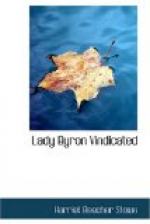(For drawn from reptiles only may we trace
Congenial colours in that soul or face,)
Look on her features! and behold her mind
As in a mirror of itself defined:
Look on the picture! deem it not o’ercharged
There is no trait which might not be enlarged.’
The poem thus ends:—
’May the strong curse of crushed
affections light
Back on thy bosom with reflected
blight,
And make thee in thy leprosy of
mind
As loathsome to thyself as to mankind!
Till all thy self-thoughts curdle
into hate,
Black—as thy will for
others would create;
Till thy hard heart be calcined
into dust,
And thy soul welter in its hideous
crust.
O, may thy grave be sleepless as
the bed,
The widowed couch of fire, that
thou hast spread
Then when thou fain wouldst weary
Heaven with prayer,
Look on thy earthly victims—and
despair!
Down to the dust! and as thou rott’st
away,
Even worms shall perish on thy poisonous
clay.
But for the love I bore and still
must bear
To her thy malice from all ties
would tear,
Thy name,—thy human name,—to
every eye
The climax of all scorn, should
hang on high,
Exalted o’er thy less abhorred
compeers,
And festering in the infamy of years.’
March 16, 1816.
Now, on the 29th of March 1816, this was Lord Byron’s story. He states that his wife had a truthfulness even from early girlhood that the most artful and unscrupulous governess could not pollute,—that she always panted for truth,—that flattery could not fool nor baseness blind her,—that though she was a genius and master of science, she was yet gentle and tolerant, and one whom no envy could ruffle to retaliate pain.
In September of the same year she is a monster of unscrupulous deceit and vindictive cruelty. Now, what had happened in the five months between the dates of these poems to produce such a change of opinion? Simply this:—
1st. The negotiation between him and his wife’s lawyers had ended in his signing a deed of separation in preference to standing a suit for divorce.
2nd. Madame de Stael, moved by his tears of anguish and professions of repentance, had offered to negotiate with Lady Byron on his behalf, and had failed.
The failure of this application is the only apology given by Moore and Murray for this poem, which gentle Thomas Moore admits was not in quite as generous a strain as the ‘Fare thee well.’
But Lord Byron knew perfectly well, when he suffered that application to be made, that Lady Byron had been entirely convinced that her marriage relations with him could never be renewed, and that duty both to man and God required her to separate from him. The allowing the negotiation was, therefore, an artifice to place his wife before the public in the attitude of a hard-hearted, inflexible woman; her refusal was what he knew beforehand must inevitably be the result, and merely gave him capital in the sympathy of his friends, by which they should be brought to tolerate and accept the bitter accusations of this poem.




